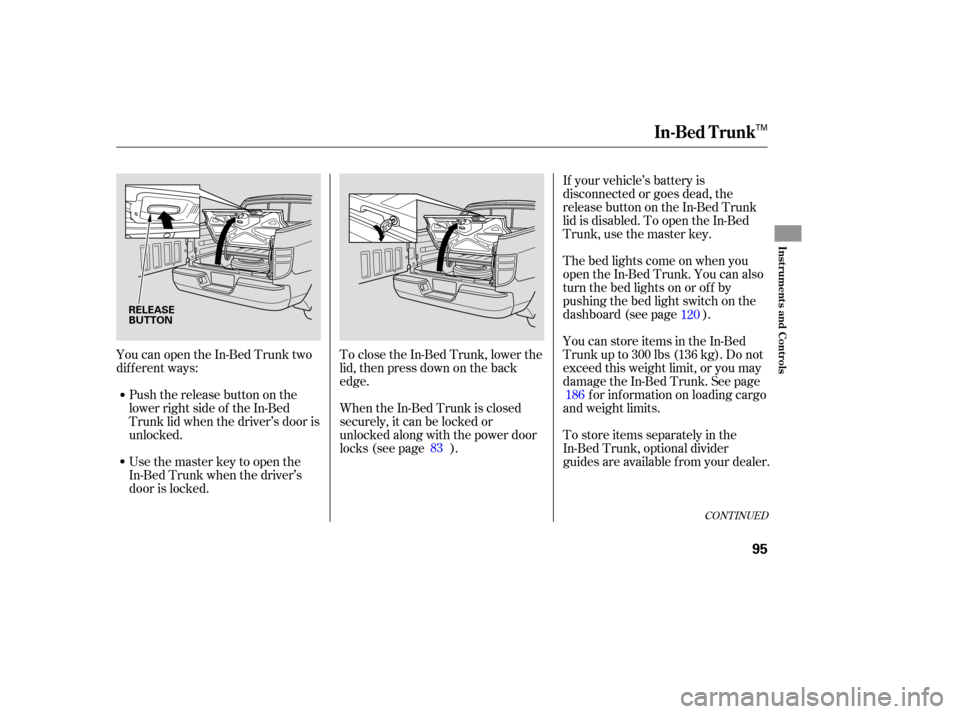Page 99 of 331

YoucanopentheIn-BedTrunktwo
different ways:
Push the release button on the
lower right side of the In-Bed
Trunk lid when the driver’s door is
unlocked. To
close the In-Bed Trunk, lower the
lid, then press down on the back
edge. If
your vehicle’s battery is
disconnected or goes dead, the
release button on the In-Bed Trunk
lid is disabled. To open the In-Bed
Trunk, use the master key.
Usethemasterkeytoopenthe
In-Bed Trunk when the driver’s
door is locked. Thebedlightscomeonwhenyou
open
the In-Bed Trunk. You can also
turn the bed lights on or off by
pushing the bed light switch on the
dashboard (see page ).
You can store items in the In-Bed
Trunk up to 300 lbs (136 kg). Do not
exceed this weight limit, or you may
damage the In-Bed Trunk. See page
for information on loading cargo
and weight limits.
To store items separately in the
In-Bed Trunk, optional divider
guides are available from your dealer.
When
the In-Bed Trunk is closed
secu rely, it can be locked or
unlocked along with the power door
locks (see page ). 83 120
186
CONT INUED
In-Bed Trunk
Inst rument s and Cont rols
95
RELEASE
BUTTON
TM
Page 187 of 331
For example, an underinflated tire
causes more ‘‘rolling resistance,’’
which uses more fuel.
The build-up of snow or mud on
your vehicl e’s underside or on the
truck bed adds weight and rolling
resistan ce. Frequent cleaning
helps your fuel mileage and
reduces the chance of corrosion.
Drive moderately. Rapid
acceleration, abrupt cornering,
and hard braking use more fuel.
Always drive in the highest gear
possible. Try
to maintain a constant speed.
Everytimeyouslowdownand
speed up, your vehic le uses extra
fuel. Use cruise control when
appropriate.
Combine several short trips into
one.
The air conditioning puts an extra
load on the engine which makes it
usemorefuel.Usethefresh-air
ventilation when possible.
Always
maintain your vehicle
according to the maintenance
messages displayed on the
inf ormation display. See on page
.
241
Improving Fuel Economy
Owner’s
Maintenance Checks
Fuel Economy
Bef ore Driving
183
Page 191 of 331

�µ�·
Locate
the statement, ‘‘the
combined weight of occupants and
cargo should never exceed 1,530
(1,480) lbs’’ on your vehicle’s
placard. [The placard is on the
driver’s doorjamb.]
To
determine the correct cargo and
luggage load limit:
The maximum load for your vehicle
is:
Determine the combined weight
of the driver and passengers that
will be riding in your vehicl e.
Subtract the combined weight of
the driver and passengers from
1,530 (1,480) pounds.
The resulting figure equals the
available amount of cargo and
luggage load capacity. For
example, if the maximum load is
1,530 lbs and there will be five 150
lb. passengers in your vehicle, the
amount of available cargo and
luggage load capaci ty is 780 lbs.
[1,530 750 (5 150) = 780 lbs.] Determine
the combined weight
of luggage and cargo being loaded
in the vehicle. That weight may
not safely exceed the available
cargo and luggage load capaci ty in
step 4.
If your vehicle will be towing a
trailer, load from your trailer will
be transf erred to your vehicle.
Consult this manual to determine
how this reduces the available
cargo and luggage load capacity of
yourvehicle(seepage ).
These f igures include the total
weight of all occupants, cargo, and
accessories, and the tongue load if
you are towing a trailer.
In addition, the total weight of the
vehicle, all occupants, accessories,
cargo, and trailer tongue load
must not exceed the gross vehicle
weight rating (GVWR) or the
gross axle weight rating (GAWR).
Bothareonalabelonthedriver’s
doorjamb.
1.
2.
3.
4.
5.
6.
212
On vehicles without moonroofOn vehicles with moonroof
Carrying Cargo
L oad L imits (Payload)
Bef ore Driving
187
1,530 lbs (690 kg)
1,480 lbs (670 kg)
Overloading or improper
loading can affect handling and
stability and cause a crash in
which you can be hurt or killed.
Follow all load limits and other
loading guidelines in this
manual.
Page 192 of 331

Store or secure all items that could
be thrown around and hurt
someone during a crash.Distribute cargo evenly on the
f loor in the In-Bed Trunk, placing
the heaviest items on the bottom
and as far forward as possible. Tie
down items that could be thrown
during a crash or sudden stop.
Make sure the In-Bed Trunk lid is
closed securely bef ore driving.
Be sure the total weight of the
items in the In-Bed Trunk does not
exceed 300 lbs (136 kg).
If you use an accessory roof rack,
the roof rack weight limit may be
lower. Ref er to the inf ormation that
came with your roof rack.
Be sure items placed on the f loor
behind the f ront seats cannot roll
under the seats and interf ere with
the driver’s ability to operate the
pedals, the proper operation of the
seats, or proper operation of the
sensors under the seats.
Keep the glove box closed while
driving. If it is open, a passenger
could injure their knees during a
crash or sudden stop.
If youfoldtherearseatsup,tie
down items that could be thrown
about the vehicle during a crash or
sudden stop. Also, keep all cargo
below the bottom of the windows.
If it is higher, it could interf ere
with the proper operation of the
side curtain airbags.
Distribute cargo evenly on the
floor of the cargo area with the
rear seats f olded up, placing the
heaviest items on the bottom and
as far forward as possible. Tie
If you carry any items on a roofrack,besurethetotalweightof
the rack and the items does not
exceed 110 lb (50 kg).
Carrying Items in the Passenger
Compartment
Carrying Cargo in the In-Bed
T runk or on a Roof Rack
Carrying Cargo
188
down items that could be thrown
about the vehicle during a crash
or sudden stop.
Page 193 of 331

CONTINUED
Your vehicle can carry a large
amount of cargo in the pickup bed.
However, the pickup bed is not
intended for carrying passengers.
Peoplewhorideinthepickupbed
can be very seriously injured or
killed in a crash (see page ).
Make sure your cargo is properly
load ed and all items are secu red so
they will not shift or fall out while
driving. When
loading and unloading cargo,
make sure all passengers or any
objects are clear of the tailgate
befo re opening or closing it. The
tailgate should be closed securely
befo re driving when it is not used
as the extended pickup bed.
The maximum allowable loading
weight on the pickup bed is 1,100
lbs (500 kg). Do not exceed the
load limit (see page ).
Distribute cargo evenly on the
pickup bed. Place the heaviest
items on the bottom and as f ar
f orward as possible of the rear
axle. Tie down and secure all
items that could be thrown out of
the vehicle during a crash or
sudden stop. If you stack items higher than the
bed sides, tailgate, or back window,
secure them with a net or cover.
This will reduce the risk of items
beingthrownoutof thepickup
bed during a crash or sudden stop.
When the tailgate is dropped open,
itcanbeusedasanextended
pickup bed. The maximum
allowable weight on the tailgate
while driving is 300 lbs (136 kg).
Exceeding this limit could damage
the tailgate.
Carrying heavy cargo in the
pickup bed will raise your vehicle’s
center of gravity. This can affect
handling and perf ormance. Drive
more slowly and cautiously, and
allow extra time and distance f or
braking.
8
187
Carrying Cargo
Carrying Cargo in the Pickup Bed
Bef ore Driving
189
Allowing passengers to ride in
the pickup bed or on the tailgate
can result in death or serious
injury in a crash.
Make sure all passengers ride
in a seat and wear a seat belt
properly.
Page 195 of 331
The cargo net can be used to hold
lightweight items in the pickup bed.
Secure all items properly. The net
may not prevent heavy items f rom
beingthrownoutwardinacrashora
sudden stop.The cargo cover can be used to
cover the cargo area on the pickup
bed.
Your vehicle’s pickup bed has a rust
resistant surf ace. To repair small
chips and scratches in the bed, a
repair kit is available f rom your
dealer. More extensive damage
should be repaired by your dealer.
To avoid problems with the bed
surf ace and the In-Bed Trunk lid, do
not use spray-in bed liner products.
Carrying Cargo
Optional Cargo Net
Optional Cargo Cover
Pickup Bed Repair
Bef ore Driving
191
Page 197 of 331

This section gives you tips on
starting the engine under various
conditions, and how to operate the
automatic transmission. It also
includes important inf ormation on
parking your vehicle, the braking
system, the VTM-4 system, the VSA
system, the tire pressure monitoring
system, and f acts you need if you are
planning to tow a trailer.........................
Driving Guidelines .194
........................
Preparing to Drive .195
.......................
Starting the Engine .196
..............
Automatic Transmission .197
Variable Torque Management
.............
4WD (VTM-4) System .203
Tire Pressure Monitoring System ......................................
(TPMS) .204
...........................................
Parking .206
.............................
Braking System .207
...............
Anti-lock Brakes (ABS) .208
Vehicle Stability Assist (VSA)
........................................
System .210
.................
Towing Weight Limits .212
..........
Towing Weight Guidelines .214
...........................
Towing a Trailer .215
Of f -Highway Driving
..................................
Guidelines .227
Driving
Driving
193
Page 216 of 331

The maximum weight of the trailer
andeverythinginoronitdependson
the number of occupants in your
vehicleandthetypeoftrailerbeing
towed (see page ).
To wing a load that is too heavy can
seriously affect your vehicle’s
handling and performance.
Your
vehicle has been designed to
tow a trailer, as well as carrying
passengers and their cargo. To
safety tow a trailer, you should
carefully observe the load limits (see
page ), use the proper equipment,
and follow the guidelines in this
section.
Be sure to read the
sectiononpage
if you plan to tow off paved
surfaces.
The weight that the tongue of a fully-
loaded trailer puts on the hitch
should follow the recommended load
guidelines (see page ). Too
much tongue load reduces f ront-tire
traction and steering control. Too
little tongue load can make the
trailer unstable and cause it to sway.
187
214214
227
T ot al T railer Weight
T ongue L oad
Load Limits
Off-Highway
Driving Guidelines
Towing Weight Limits
212
Exceeding any load limit or
improperly loading your vehicle
and trailer can cause a crash in
which you can be seriously hurt
or killed.
Check the loading of your
vehicle and trailer carefully
beforestartingtodrive.